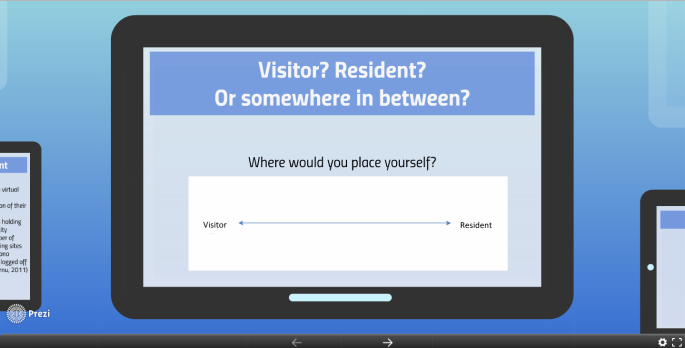Out with the old, in with the new
The concept of digital “visitors” and “residents” offers a new way of interpreting how people participate in the digital world, providing a replacement for Prensky’s seemingly out-dated and heavily criticised notion of digital “natives” and “immigrants” (White and Le Cornu, 2011).
According to Prensky “today’s students think and process information fundamentally differently from their predecessors” (Prensky, 2001, p.1) thus he believed that people of the newly centralised digital world fitted within one of two distinct categories, subsequently coining the terms ‘digital natives’ and ‘digital immigrants’.
Digital Native
- Born during or after the digital age
- Students
- Fast
- Young
Digital Immigrant
- Born before the digital age
- Teachers
- Slow
- Old
Presumptuous and farfetched, and based solely on opinion it is no wonder the once widely recognised phenomenon has come under much scrutiny in recent years. Bennet et al. (2008) claims there is little evidence to suggest the younger generation process information differently, a claim supported by Prensky, who declared that the use of technology and its effect on cognitive processes is still being explored by neuroscientists (Prensky, 2001). Arguably over-simplistic (Luckin et al. 2009) harbouring nothing more than a predisposed assumption that a student’s digital literacy is far more adept than it actually is and creating a sense of panic among ‘immigrant’ educators who deemed themselves “wrong footed and unable to step-up to the plate” (Kuehn, 2012, p.131). I believe Prensky’s notion limits the capabilities of those like myself possessing a ‘can do’ attitude, with the motivation and passion to learn and adapt to the ever changing world around them.
Beetham and Sharpe (2010) acknowledge this in their ‘pyramid model’ of digital literacy describing the process as a development from ‘access’ through to the ability to create and hold an online identity. Unlike Prensky’s notion the new “visitors” and “residents” concept allows for this.

Beetham and Sharpe ‘pyramid model’ of digital literacy development model (2010)
Similar to marauders, as outlined in David Canter’s 2003 book Mapping Murder: The Secrets of Geographical Profiling, who maunders into an area to commit a crime, a “visitor” migrates onto the internet only to achieve a specific goal (Canter, 2003). Viewing the internet as a set of ‘tools’, the visitor is unlikely to hold any form of online profile, using ‘tools’ such as email and Skype to communicate in a more rapid manner than offline communicative methods would permit. Contrastingly, a “resident” sees the web as a virtual community frequently using sites such as Facebook and Twitter, thus when a resident logs off “an aspect of their persona remains” (White and Le Cornu, 2011).
Furthermore, the concept allows individuals to place themselves along a continuum rather than having to fit within one of two restricting categories.
To find out more about the continuum take a look at my Prezi below!
References
Beetham, H. and Sharpe, R. (2010) Beetham and Shapre ‘pyramid model’ of digital literacy development model. Available at: https://www.jisc.ac.uk/guides/developing-digital-literacies (Accessed: 12 February 2017).
Bennet, S., Maton, K. and Kervin, L. (2008) ‘The ‘digital natives’ debate: A critical review of the evidence’, British Journal of Educational Technology, 39(5), pp.773-964. Available at: http://ro.uow.edu.au/cgi/viewcontent.cgi?article=2465&context=edupapers
Canter, D.V. (2003) Mapping Murder: The Secrets of Geographical Profiling. London: Virgin Books.
Kuehn, L. (2012) ‘No More “Digital Natives” and “Digital Immigrants”’, Our Schools, Our Selves, 21(2), pp.129-131. Available at: http://teachandtechassign3.weebly.com/uploads/1/4/2/0/14202725/no_more_digital_natives_and_immigrants.pdf (Accessed: 12 February 2017).
Luckin, R et al. (2009) ‘Do Web 2.0 tools really open the door to learning? Practices, perceptions and profiles of 11-16-year-old students’, Learning, Media and Technology, 34(2), pp. 87-104. doi: 10.1080/17439880902921949
Prensky, M. (2001) ‘Digital Natives, Digital Immigrants’, On the Horizon, 9(5) Available at: http://www.marcprensky.com/writing/Prensky%20-%20Digital%20Natives,%20Digital%20Immigrants%20-%20Part1.pdf (Accessed: 12 February 2017).
White, D.S. and Le Cornu, A. (2011) ‘Visitors and Residents: A new typology for online engagement’, First Monday, 16(9) Available at: http://firstmonday.org/article/view/3171/3049%20https://comminfo.rutgers.edu/%257Etefko/Courses/Zadar/Readings/Selwyn%20dig%20natives,%20Aslib%20Proceedings%202009.pdf (Accessed: 12 February 2017).


One thought on “Topic 1”